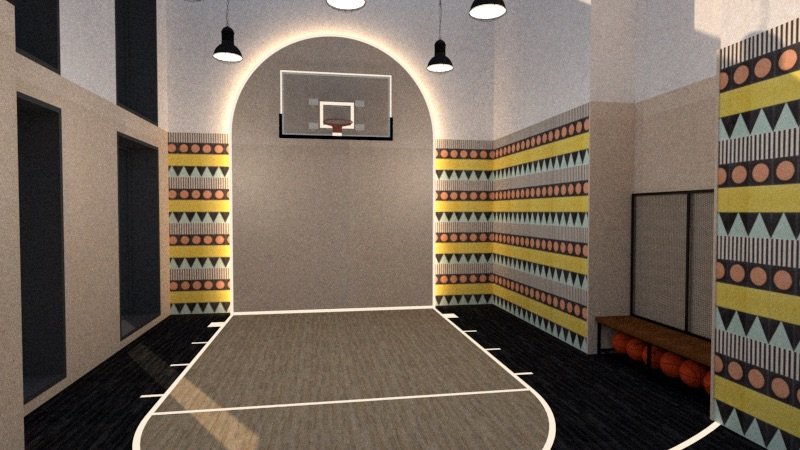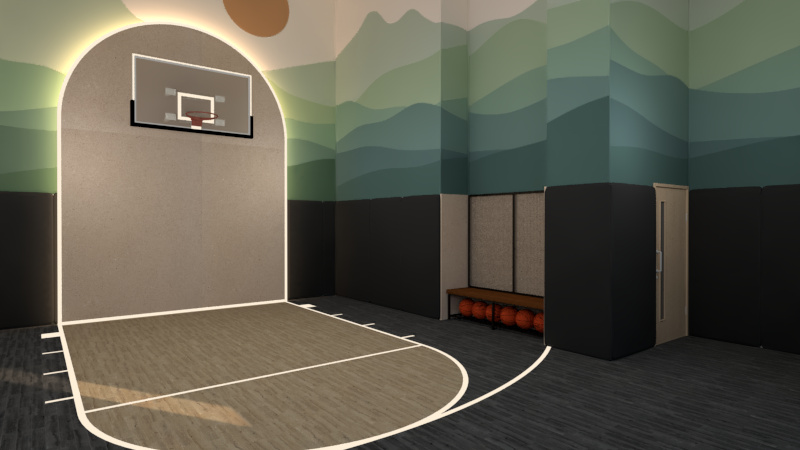Indoor basketball court design
indoor basketball court design by biofit
Introduction to indoor basketball court design
Indoor basketball and multi-purpose courts
One leisure facility that has become increasingly popular in recent years for co-living and student accommodation developments is the indoor basketball half court or multi-purpose indoor sports court.
Indoor basketball courts offer students a wide range of physical and mental health benefits, plus they can also double up as indoor badminton courts.
Not only do they provide an opportunity for vigorous exercise they are the perfect environment to socialize with other students, something that a pilates or yoga studio may struggle with as the practice is far more solitary.
Additionally, the presence of an indoor basketball court can add tangible sales & marketing value to a residential development, helping to attract tenants and increase occupancy rates without the need to invest in a full sports centre or sports hall. In our experience, student halls with a basketball court make do with 60m2-80m2 of double-height space.
As such, developers need to consider the design of their indoor basketball courts or half hall court carefully in order to maximize its potential as an asset, alongside a designer gym and wellness studio. That’s where we come in as specialist designers in leisure spaces and wellness facilities!
Importance of leisure spaces and amenities
Studies have shown that co-living residents and students are looking for more than just a bedroom when they are choosing their accommodation nowadays and this is a sector ripe with innovation with major brands disrupting the industry like never before.
As reference, see PBSA News for all the latest updates on the purpose built student accommodation in particular, where creative innovation is ripe.
Co-living residents want a place to sleep and eat, yes but also to relax, socialize and stay healthy through exercise, so it is essential that developers factor this into their design plans.
Social benefits
Not only will an indoor basketball court provide residents with a dedicated recreational space, but it can also help to create a sense of community within the development and provide an opportunity for social interaction.
Design principles
In order to ensure that an indoor basketball court is an effective asset for a residential development, developers must take into account several factors such as safety, accessibility, lighting and ventilation.
It is also important to consider the size of the court (there is a minimum amount of space needed for this concept to work) and its location within the building (ideally ground floor with external glazing so passers by can see it!) in order to maximize its potential as an amenity for tenants and as a marketing asset.
SUSTAINABILITY CONSIDERATIONS
Sustainable materials and finishes
Another key aspect of interior design for indoor basketball courts is the selection of healthy, sustainable materials and finishes that not only enhance the visual appeal of the space but also contribute to its durability and ease of maintenance.
High-quality flooring materials, such as hardwood or eco flooring tiles specifically for indoor sports court, for example those from ECORE or Tarkett, are our preference.
Colour choices can be limited with other suppliers but these two offer far more options than any others we’ve found so far.
Padded wall panels, sports halls wall panels and acoustic wall panels are also an opportunity to introduce sustainable materials into the design. Although squash courts walls are just as likely to cause a nasty bruise or two, a student halls sports court somehow comes with a degree of extra responsibility in our view!
The rise of wellness studios and indoor sports facilities in PBSA developments
As student demand for leisure spaces and amenities continues to grow, developers are beginning to explore more creative solutions to increase sports hall bookings and brand value.
Wellness studios and indoor sports facilities offering something such as climbing walls (or rather, mini bouldering walls with minimal health and safety risks), mini golf courses and e-gaming rooms are all becoming increasingly popular in PBSA developments.
These facilities can provide students with a range of physical and mental health benefits, while also providing an opportunity for social interaction and recreation.
By incorporating these types of facilities into their designs, developers can ensure that their PBSA developments remain attractive to tenants and offer a unique experience for student living.
indoor basketball court design biofit
Benefits of having an indoor basketball court in CO-LIVING developments
Having an indoor basketball court in a co-living or PBSA development can bring many benefits, both for the tenants and the developer.
First of all, it is a great way to encourage physical activity and fitness amongst residents, which can help them to stay fit and healthy.
It can also be used as a space for socializing and team building activities, helping to create a sense of community within the development.
Finally, having a gym with an indoor basketball court can add value to the development and make it more attractive to potential tenants.
Factors to consider when designing an indoor basketball court for PBSA development
When designing an indoor basketball court for a PBSA development, it is important to consider the size of the court and its location within the building.
The court should be large enough to accommodate multiple players, while still being located in a convenient area that allows for easy access.
It is also important to consider factors such as safety, accessibility, lighting and ventilation in order to ensure that the court is comfortable and safe for all users.
LIGHTING
Lighting is another critical component of interior design for indoor basketball courts. Adequate illumination is necessary to ensure optimal playing conditions and promote safety obviously but also to create a certain ambiance, especially after dark.
Heavy-duty sports court lights from suppliers such as Philips represent value for money and a fool-proof solution, rather than trying to hang standard luminaires from the ceiling and hoping the balls avoid them in future!
Finally, designers must take into account the aesthetic of the court and ensure that it complements the overall design of the building.
Multi-purpose court designs - what other activities can an indoor basketball court be used for?
An indoor basketball court can be used for a variety of activities beyond just basketball.
Volleyball, badminton and table tennis can all be played on the court, while it can also be used for yoga sessions and other forms of exercise.
In addition, an indoor basketball court can be used as a social space for tenants to relax, study or host events.
Finally, an indoor basketball court can also be used as a venue for live music performances, workshops or other entertainment activities.
Working with a designer to create a unique and functional indoor basketball court
When designing an indoor basketball court for a co-living or PBSA development, it is important to work with an experienced designer who understands the specific needs of the development.
The designer should be able to create a unique court that is tailored to the space available and can accommodate different activities.
It is also important to consider factors such as lighting, ventilation and safety when working with a designer in order to ensure that the court meets all necessary requirements.
By working with a professional designer, developers can create an indoor basketball court that meets their tenants’ needs while also adding value and appeal to their co-living development.
Incorporating branding, wall murals and visual identity elements into the interior design of indoor basketball courts can help to create a sense of place and foster a sense of pride among residents, or indeed become a powerful marketing tool for the developer looking to attract new residents.
Conclusion and future trends in co-living amenities
When designing an indoor basketball court for co-living or PBSA, it is important to consider the amount of floor space available, the number of players that will be using it and the type of surface they will be playing on.
Multi-purpose court designs are becoming increasingly popular as they offer more versatility and are easier to maintain.
For example, a multi-purpose court can be used for basketball, volleyball or badminton depending on what activities students want to participate in.
Integrating the basketball court with other on-site facilities is also important in order to maximize its usage and strengthen its appeal to potential students.
Working with a designer can help create a unique and functional indoor basketball court that meets the specific needs of the development.
Examples of successful indoor basketball courts can be seen in various co-living and PBSA developments around the world, such as student accommodation complexes in Australia, Europe and North America.
Going forward, we can expect to see an increase in leisure spaces and amenities offered by co-living and PBSA developments as student expectations continue to evolve with time.
Indoor sports facilities such as basketball courts will remain popular among residents due to their versatility and convenience.
Developers should consider working with designers who specialize in creating unique multi-purpose sports courts that can meet the specific needs of clients during their development.


